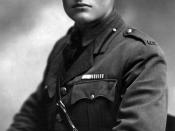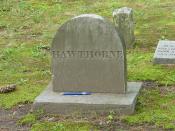"All stories, if continued far enough, end in death, and he is no true story teller who would keep that from you," Ernest Hemingway once wrote. This is a sentiment shared by another prominent writer, Nathaniel Hawthorne, whose own stories often include or focus on death. That death plays a part in their stories is a common denominator between Hemingway and Hawthorne, but they handle the subject in different manners. The two authors hold philosophies that are similar in their view of the world, but their attitude toward man and how he should face life differs. There are aspects in their work, aside from death, that illustrate their comparable outlooks on life. However, two of their most notable characters, Santiago and Hester Prynne, are portrayed in a contrasting fashion. The constant between Hemingway and Hawthorne is in the subject matter of their work, while the variable is in their characters and how they handle certain situations.
Hemingway and Hawthorne see the world with a slightly jaded perspective: Hemingway as part of the "lost generation" whose views were shaped by war and other less than pleasant events; Hawthorne because of his connection with the Puritan way of life. Their experiences had a profound effect on their writing and their picture of the world as an unrelenting, challenging place. Many obstacles befall their protagonists. In Hemingway these obstacles are more of the physical variety, while in Hawthorne they are of the spiritual; in both they are representative of the harsh world each author perceives. Hawthorne's viewpoint is darker than Hemingway's, but all the same both authors show that there are bright spots in life. They do not show the bright spot as part of the world itself, but rather as the quality of individual life. The world can be good, or...


